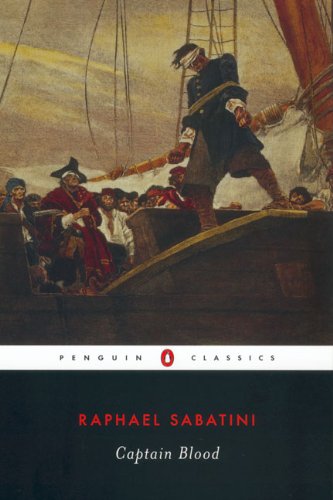 Very piratical. And romantical.
Very piratical. And romantical.
Not really bloody. Or violent. Well, not very. I mean, there are pirates. But Captain Peter Blood (that’s his real name) is a gentleman pirate. He only kills bad guys. And a lot of the really bad, violent stuff occurs off-stage, so to speak. Captain Blood reminds me of Captain Jack Sparrow, sort of quirky and not always trustworthy. He lives by his own code of honor and morality, and it’s not exactly the traditional one of his time and culture. Still, Captain Blood sees himself, and others mostly see him, as a gentleman, forced into piracy by circumstances beyond his control and trying to make the best of it.
The story begins in England, 1685. (You can read an article with detailed historical background to the novel here.) Peter Blood is a “bachelor of medicine and several other things besides.” He becomes inadvertently involved in the Monmouth Rebellion against King James II of England. Although he is innocent, guilty only of sheltering and assisting medically one of the fleeing rebels, Blood is convicted of treason, and in lieu of a sentence of execution, he is sent to Barbados as a slave. Eventually after years of captivity, Peter Blood escapes from his master in Barbados, but since he is an outlaw and an escaped slave with a price on his head, he has little choice but to become a buccaneer, or privateer, or in common parlance, a pirate.
Some of the events in Peter Blood’s career as a pirate sound very similar to the exploits of the actual pirate Henry Morgan, fictionalized in John and Patricia Beatty’s book, Pirate Royal. Sabatini explains this similarity in his book by saying that Captain Morgan’s biographer, Esquemeling, must have read the ship’s log of Captain BLood’s ship. “Esquemeling must have obtained access to these records, and he plucked from them the brilliant feathers of several exploits to stick them into the tale of his own hero, Captain Morgan. I mention it chiefly as a warning, for when presently I come to relate the affair of Maracaybo, those of you who have read Esquemeling may be in danger of supposing that Henry Morgan really performed those things which are veraciously attributed to Peter Blood.”
So, Captain Blood, the epitome of the pirate adventure story, published in 1922, is a good bet to recommend to teens and adults looking for pirate books. The Sea Hawk is another pirate story from the pen of the prolific Sabatini. Both of these novels were adapted into movies by the Hollywood film machine of the 1920’s and 1930’s, twice each, first as silent films and again as “talkies”, the latter starring the swashbuckling film hero, Errol Flynn.